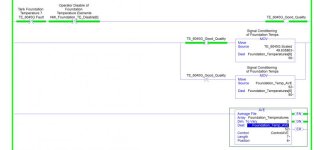Hello again,
Looking to use an AVE block in ladder to calculate the average of 7 temperature elements in the foundation of an LNG tank. My issue is the AVE block only executes once when the rung is initiated but I want this to be continuous. Am I using the right block for my situation? If so, what would be a simple way to make this block work each scan?
I've attached an image of code. Thanks in advance for any help.

Looking to use an AVE block in ladder to calculate the average of 7 temperature elements in the foundation of an LNG tank. My issue is the AVE block only executes once when the rung is initiated but I want this to be continuous. Am I using the right block for my situation? If so, what would be a simple way to make this block work each scan?
I've attached an image of code. Thanks in advance for any help.






